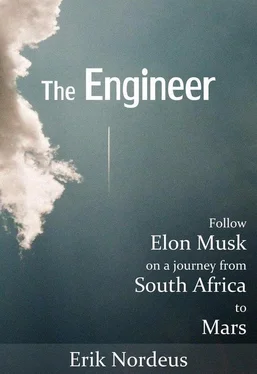The second launch was supposed to happen in January 2007, but was delayed until March 2007. Falcon 1 flew to an altitude of 180 miles [290 km], before it failed to reach orbit. It’s possible to see on the launch video how, after 2 minutes and 50 seconds, the rocket separates as it was supposed to, and how the first stage falls back to Earth. The first stage could never be found again due to a broken GPS transmitter. The reason why Falcon 1 failed this time was that an engine had stopped 90 seconds too early.
There was a time when more electric cars drove on the roads than there were cars powered by fossil fuels. In 1900, electric motors powered 34 percent of the cars in New York, Boston, and Chicago. A steam or a combustion engine powered the other cars. 385
Manufactured in the late 1800s, the first electric cars were quiet, clean, and could be charged in the home. 59The torpedo shaped electric car, The Never Satisfied , was the first vehicle to reach a speed over 62 mph [100 km/h]. Those who saw the record thought they were going to die if they traveled so fast. While Henry Ford mass produced gasoline cars, his wife Clara Ford drove a 1914 Detroit Electric with a range of 80 miles [130 km] and a speed of 20 mph [32 km/h]. 218
Around 1920, the gasoline cars began to outnumber the electric because they were easier to refuel. In most smaller towns in America, the gasoline car arrived before electricity. The gasoline car was also less expensive. You could buy three of Ford’s Model T for the price of just one electric car. 59,329Several car manufacturers have since then again and again tried to sell electric cars. But all models failed. They didn’t always fail because the cars were expensive, slow, ugly, or had a limited range – they could also fail because the auto manufacturers wanted them to fail. The best example is General Motors’s EV1.
At the 1990 Los Angeles Auto Show, General Motors revealed an electric concept car: the Impact. Because of the name, you could hear comments like, “What’s next, the Ford Whiplash?” General Motors announced at the same time how the Impact would become a vehicle for the mass market. The California Air Resources Board realized this new generation of electric vehicles could solve the state’s problem with pollution. The same year, they passed the Zero-Emission Vehicle mandate. It said that if a car manufacturer wanted to sell cars in California, some cars must be free from exhaust. California was a large market, so the car manufacturers didn’t have any other choice than to begin selling electric cars. 330
The Impact evolved into the EV1 [Electric Vehicle 1]. It became the first modern mass produced electric car – 1117 were manufactured between 1996 and 1999. The EV1 had two seats, a futuristic shape where the rear wheels were almost covered, it was developed in California, and was supposed to be the first in a series of electric vehicles. The next car in the series would be called EV2, the next EV3, and so on. “This is going to represent a great step forward for people in terms of commuting to work, from work, if you don’t have to go more than 120 miles [190 km] a day,” the CEO of General Motors explained when he introduced the car.
Several celebrities enjoyed driving the EV1. The only sound they could hear from the car was a slight hum and the quiet clicks from the brakes. Because there was no lag between pedal and power, the EV1 owner and actor, Mel Gibson, thought he drove the same car as the superhero Batman. “With no gears to complicate acceleration, you get that launched sort of feeling, a childish giddiness called the EV smile,” a driver said. 330
Another famous EV1 driver was Alexandra Paul, who played a lifeguard in the television series Baywatch . “Mine [EV1] was forest green, got 70 miles [113 km] on a charge, and handled like a Porsche,” she said. “A couple years later, improved battery technology in the EV1 allowed me to get 100 miles to a charge and then 120 miles to a charge. It was my only vehicle, and served 95 percent of my driving needs. When I needed to go farther, I borrowed a Toyota Prius.”
Paul had previously owned two other electric cars. She had taken an interest in them ever since the oil tanker Exxon Valdez struck a reef in Alaska and 500 000 barrels of oil spilled into the sea. “I was very much on my high horse about it, until I realized that I was part of the reason that the Exxon Valdez was out there in the first place – my car needed gasoline as much as the next person’s to take me from one place to another in my daily life,” she said. 379
The actor and director, Peter Horton, wanted to join the other celebrities. “I decided to go electric,” he said. “I had seen those sleek, sort of George Jetson EV1s shoot by me with surprising speed on the freeways. I thought, fine, I’ll get an EV1.” But Horton couldn’t find one. General Motors had removed them from the market. 229
According to General Motors, the EV1 failed. They didn’t believe the car would bring in any profits to the company because the EV1 would never appeal to anyone else than a small group of technology enthusiasts and environmentalists. But before the car was removed from the streets, 4000 people had written on a list how they wanted to order the EV1. General Motors called these people and began the conversation with describing the car’s limitations. So when they came to the bottom of the list, it had shrunk to 50 people. The private individuals who supported the EV1 wondered if it really was a wise idea to sell a car by describing the limitations. This is how one of the supporters recalled a discussion with General Motors:
“What’s wrong with the batteries? The ones in my car seem to work fine,” an EV1 owner asked.
“Do you know how much it costs to replace those batteries? A lot,” a General Motors representative replied.
“Yeah, but doesn’t it cost a lot to replace a transmission or an engine in a traditional car?”
“Not as much as you’d think. An engine’s only a couple hundred.”
“That’s because you mass produce them?”
“Well, that and other factors.”
“If you mass produced the batteries, wouldn’t their cost come down?”
“Yeah, but we’re not.” 229
The final kill to the electric vehicle in California came when General Motors, Chrysler, and several auto dealers sued the California Air Resources Board. In April 2003, California killed the electric car mandate. They thought the batteries were not yet good enough to be a competitive alternative to the gasoline car.
Another technology shift happened at the same time. With one billion dollars, the US Government announced it would support the shift to hydrogen fuel-cell vehicles. 330Elon Musk is not a fan of fuel-cells and nicknamed them “fool-cells.” 328“If car companies can’t figure out anything else to do they give a technology that is always ten years into the future and something people don’t quite understand,” Elon said. “People say, ‘They are doing something for sustainable transport, but we don’t understand it and it’s ten years away.’ And then ten years go by and nothing happens.” 366
General Motors didn’t sell the EV1, the customers leased it for $250 to $500 per month. When General Motors canceled the EV1 program, they told the owners they had to turn them in or they would face legal consequences. Some owners wanted to keep their cars, so they fought back. But nothing helped. General Motors called the police who carried away the last supporters who blocked the truck that transported the last EV1 away from the roads in 2004. 330
The now heartbroken EV1 owners held a funeral for the cars. You could hear a musical piece with Scottish bagpipes and each owner held a speech. “What the contractors and critics of electric vehicles have been saying for years is true; the electric vehicle is not for everybody. Given the limited range, it can only meet the needs of 90 percent of the population,” an owner said. 330
Читать дальше











